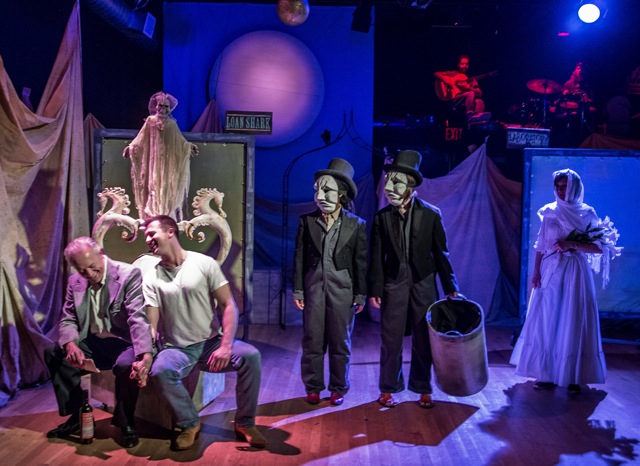Theater Review: “Ten Blocks on the Camino Real” — A Tennessee Williams Dreamscape
Beau Jest Moving Theatre has returned to the early, one-act version of Williams’ script, and created a sometimes pleasant, sometimes nightmarish dreamscape.
Ten Blocks on the Camino Real by Tennessee Williams. Directed by Davis Robinson. Sets by Judy Gailen. Masks by Libby Marcus. Costumes by Fabian Aguilar. Lights by Karen Perlow. Original score by Don Dinicola. Staged by Beau Jest Moving Theatre at the Charlestown Working Theater, Boston, MA, through May 20.
The production will move to the Lucid Stage, Portland, ME, May 24 through 26.
by Terry Byrne
Dramatist Tennessee Williams described his play, Camino Real as a “grotesque comedy,” one that combined the absurdity of comic strip characters actions with a sly sense of humor. Beneath some garish slashes of color, Williams layered an allegorical text rich in heartbreak and hope. But Williams wrote Camino Real in 1952 in the wake of his Broadway hits (Glass Menagerie, Streetcar Named Desire, Summer and Smoke and The Rose Tattoo) and audiences were primed for more of the same, delivered within the framework of theatrical realism. Williams’ interest in “plastic theater,” one in which music, words, costumes and dance all played a role in the storytelling, did not fit the commercial considerations of Broadway, and director Elia Kazan’s 1953 production of Camino Real received a critical drubbing.
Beau Jest Moving Theater, known for its playful approach to storytelling (including the delightful adaptation of the comic strip Krazy Kat), has returned to the early, one-act version of Williams’ script, Ten Blocks on the Camino Real, and created a sometimes pleasant, sometimes nightmarish dreamscape.
Atmosphere is everything in this production, and the ensemble sets the mood, greeting audience members as they enter the theater, hawking cheap postcards, flowers, or a bit of fortune telling. We begin our journey down this imaginary South American street to the haunting strains of Santiago Cardenas’ flamenco guitar, and what follows are a selection of voyeuristic snapshots that expose characters at their most vulnerable moments.
Because the playwright is Tennessee Williams, the snippets are rich in literary references, touching on such iconic characters as a dissipated Cassanova (Robert Deveau), a deluded Don Quixote (Jordan Harrison), and a melodramatic Marguerite “Camille” Gautier (Lisa Tucker). Sometimes they seem utterly ridiculous, as in the initial appearances of Kilroy (Nick Ronan), the earnest, idealistic American who boasts “a heart as big as a baby’s head;” or the Gypsy Lauren Hallal), whose daughter Esmeralda’s (Kathleen Lewis) virginity is magically restored every year at a festival; or Guttman (Larry Coen), named after a character in The Maltese Falcon, a man who seems like a hustler but, with his penchant for pontificating, may simply be deliberately misleading us –- or are we misleading ourselves?
Director Davis Robinson doesn’t try to offer a narrative through-line, instead using the musical soundscape of Cardenas, percussionist Tamora Gooding, and musical saw, bass and foley (sound effects) by Adam Schutzman or Jon Hindmash, to create something of a pageant play. This is a dreamscape, after all, and what makes this production enchanting is Robinson’s willingness to let the various moments play out almost as if we’re catching them out of the corner of our eyes, or more often, our hearts.
No matter how disconnected the scenes may seem, underlying the humor is a dark feeling that this street leads only to doom. Although the action may shift to a silly skeleton dance or a goofy comic, moment, death is always lurking in the background. Williams takes the Mexican symbol of street sweepers as representatives of death, and twists it just enough to transform them into ruthless scavengers, coming to pick the bones of those poor souls at the end of the road. Libby Marcus’s masks for the two street sweepers are creepy, and the actors make an eerie cackling sound from behind them, creating a sense of foreboding. Marcus’s puppetry skills also appear in the guise of “The Starving Man,” a symbol of desperation who hopes for a last reprieve or final bit of human kindness, only to be denied in the end.
If there is a dramatic arc to follow along these ten blocks, it’s that of Kilroy, who arrives full of hope, but becomes first frustrated and then frightened before being led away by the street sweepers in the end. Ultimately, this seems like less of a defeat than an acceptance of death (or a poignant dream of the afterlife) as the final block on the Camino Real.
Here is Fuse Editor Bill Marx’s interview with Beau Jest director Davis Robinson about the company’s production of Ten Blocks on the Camino Real.



That’s a great picture of Williams. It’s interesting that two men and playwrights as polar opposite as Tennessee Williams and Horton Foote could have been such friends.